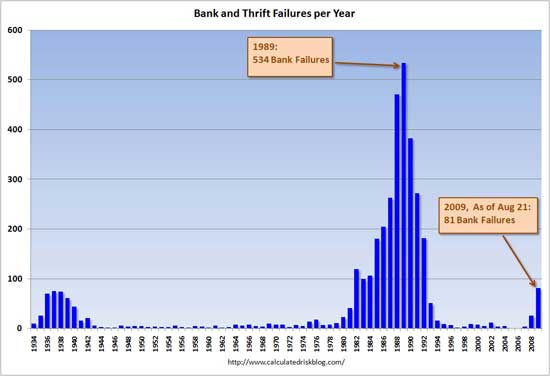The last few days have seen two well known bank analysts, Meredith Whitney and Dick Bove, going out on a limb and predicting a lot more bank failures. Neither were exactly risking their careers with these predictions.
Bove thinks 150 to 200 banks will fail during the cycle in addition to those that have already been eliminated, Whitney is looking for 300. It’s anybody’s guess and a lot depends on how the government decides to handle the problem. Nevertheless, it brought to mind this chart that Calculated Risk has published from time to time.
What strikes me about the graph is how long it took the last time to reach a peak in bank failures. It begs the question as to why it took that long and if you happened to be around then you know the answer was forbearance. The government did everything in its power to put off difficult decisions as long as possible.
We talk about “extend and pretend” and “delay and pray” today, but forget that back then those concepts were taken to extremes. Failed S&L’s were merged into failing S&L’s giving rise to something known as regulatory capital. Commercial real estate loans were routinely rolled over and even increased in order to provide for interest rate reserves that could continue to perpetuate the myth that they were performing. Sound familiar, curing leverage problems with leverage?
Ultimately, as we all know, it failed. Time just didn’t cure the fact that the properties were so far underwater that they could only return to viability via major haircuts. When the government finally capitulated to that view, the failures soared and the government ended up owning a goodly chunk of the commercial real estate in the country. You know the rest of the story. They dumped it back on the market, lots of people made lots of money and we saw the economy boom for the rest of the decade of the ’90s.
I’m not suggesting that a similar response would lead to a repeat of the economic vitality of that period, we have too many other problems for that, but we can get rid on one big anchor if we move in that direction. This chart doesn’t have to be our future but something like it will be unless we accept the facts of the banking and commercial real estate markets. We can do it now quickly or do it later, but do it we will.
- Bulenox: Get 45% to 91% OFF ... Use Discount Code: UNO
- Risk Our Money Not Yours | Get 50% to 90% OFF ... Use Discount Code: MMBVBKSM
Disclaimer: This page contains affiliate links. If you choose to make a purchase after clicking a link, we may receive a commission at no additional cost to you. Thank you for your support!




Leave a Reply